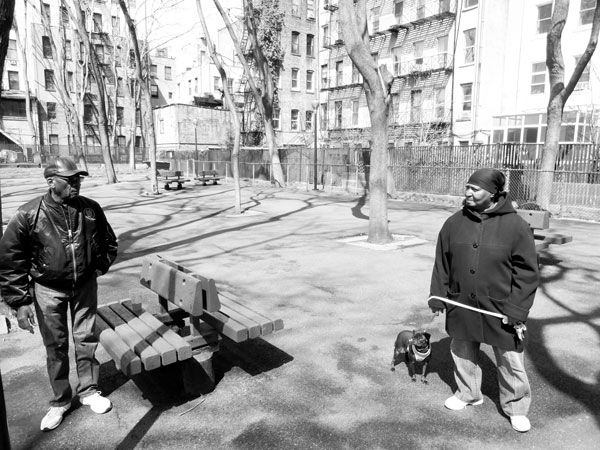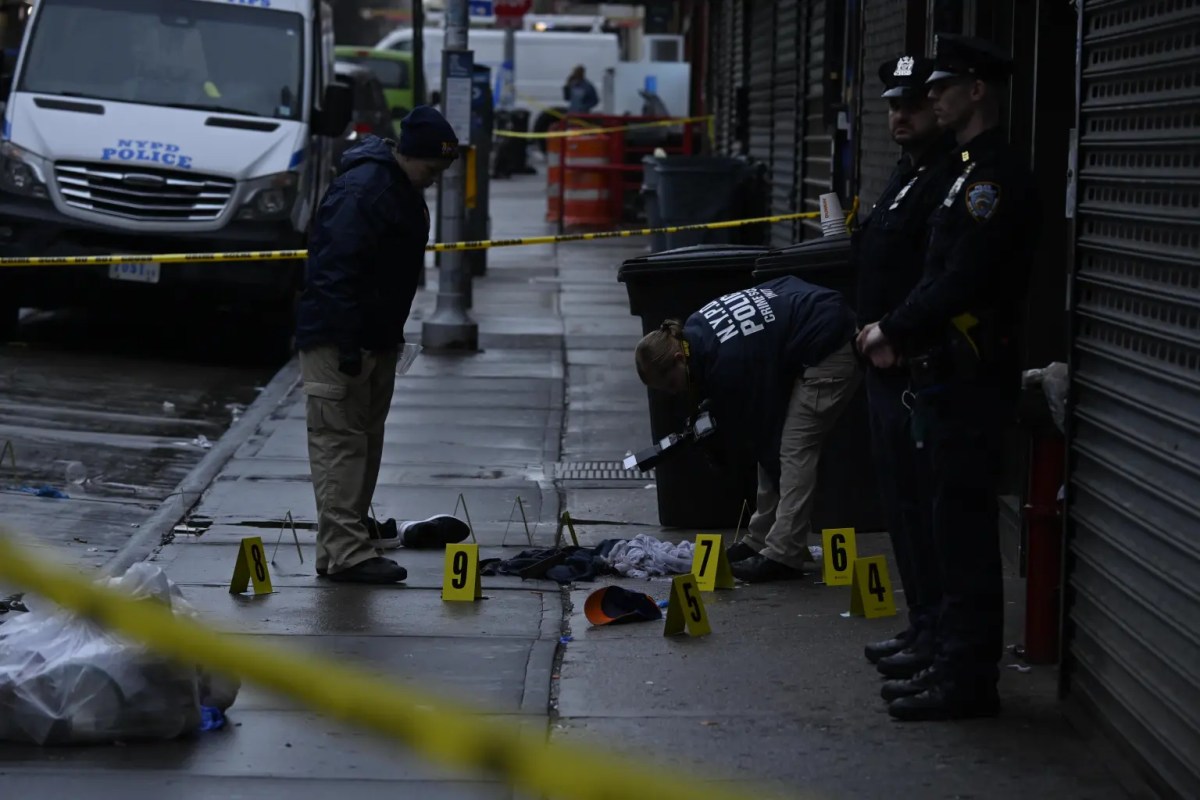
Meltzer Tower residents Issac Quinerly, left, and Shirley Jackson talking to each other in the outdoor seating area where the new “80/20” development would go.
BY PAUL BUFANO | Seniors living in one East Village apartment building rely on its park to get fresh air and to enjoy playing chess in the shade, but the green space may soon be replaced by a seven-story development with a 99-year ground lease.
The New York City Housing Authority is moving forward with a plan to allow private “infill development” on eight of its Manhattan sites, including one at Meltzer Tower, a 20-story building exclusively for seniors at 94 E. First St.
The buildings would be rentals, with a mix of 80 percent market-rate units and 20 percent affordable units. At Meltzer, an outdoor seating area with trees and benches now used by the complex’s senior residents would be replaced by a 121,500-square-foot, 97-unit building with additional space for retail stores on the ground floor.
NYCHA is set to release a request for proposals (R.F.P.) for interested developers near the end of this month, but many local residents and politicians are calling for a slowdown in the process and for greater transparency.
Issac Quinerly, 71, a Meltzer tenant and Manhattan resident since 1984, said he feels NYCHA has misled him about the details of the development.
“I went to the meetings and wasn’t impressed by what I seen,” Quinerly said. “They were talking about how they were going to save our building, so I guess that just means no more outside time for us. They’re leasing the land to a private developer for 99 years? What kind of lease is that? By the time it’s up we will all be dead!”
Karen Brown has lived in a privately owned apartment building behind the park at 105 E. Second St. for 33 years. She is a member of Friends of Meltzer, a group of local residents fighting to preserve the park for the seniors and the neighborhood.
“We are very uncomfortable with the way NYCHA is handling the project,” Brown said. “We understand that there is a deficit, and that the development will bring in money, but does it really require taking away a park for senior citizens? Meltzer has a parking lot that could be made into a profitable one. There just doesn’t seem to be any digging down for creative ideas to create revenue.”
Fred Harris, executive vice president for Development at NYCHA, said that he wants every resident to understand what’s going on, and why it’s happening.
“We have set up multiple meetings because we want to get feedback from residents, and then get back to them with helpful answers and actions,” Harris said. Referring to the meeting for the Meltzer residents, he said, “We know that not everyone speaks English, so at the meeting we had a simultaneous translation through headsets in Russian, Chinese and Spanish to ensure that everyone could follow along.”
Harris said that his primary concern is addressing the impact of the development on Meltzer residents and on the community.
“We have been looking into alternatives to taking away the park, but so far we haven’t found any,” Harris said. “It’s certainly very possible to leave a portion of the seating area, and we can do some reconfiguring, but it wouldn’t be too much smaller at this point. We understand residents enjoy it, so the plan isn’t to have the buildings right up against each other.”
Councilmember Rosie Mendez chairs the City Council’s Committee on Public Housing, which will hold a hearing on the plan at City Hall on Fri., April 5, at 10 a.m. She said she is asking NYCHA for additional meetings with meaningful input from the community to ensure that everyone’s voice is heard.
“The development has disadvantages just as it has benefits, so you really have to take everything into account,” Mendez said. “While Meltzer wasn’t flooded by Hurricane Sandy, it lost power for five days. With these buildings, developers will include generators so that in the event of a blackout, [the whole complex] can stay powered up, which is crucial for a senior population.”
A significant portion of the money generated from the new buildings will go toward repairs and maintenance, including fixing roofs, elevators and lobbies and upgrading security systems in the existing complexes where the new projects are sited.
NYCHA reports that Meltzer Tower needs $10.5 million in capital building improvements over the next five years.
Harris said the new tower would help pay for the necessary work. He estimated it would generate around $970,000 annually — based on the projected 97 apartments providing an average of about $10,000 per year.
“Aside from rent revenue, the new development would also create many temporary construction jobs, and then permanent employment opportunities in the retail stores on the ground floor,” he added. “There’s no doubt that it will stimulate the economy in the area.”
Quinerly said that despite the project’s alleged benefits for Meltzer, he was still skeptical any good will come from it.
“I love the area and don’t ever want to leave, but if a community is going to be ignored and overlooked, what other choice do I have?” Quinerly asked. “The sad thing is not many other people here have that option to leave like me. I really hope these officials don’t take my words lightly because a lot of lives could be impacted, and not necessarily in the best of ways.”

















